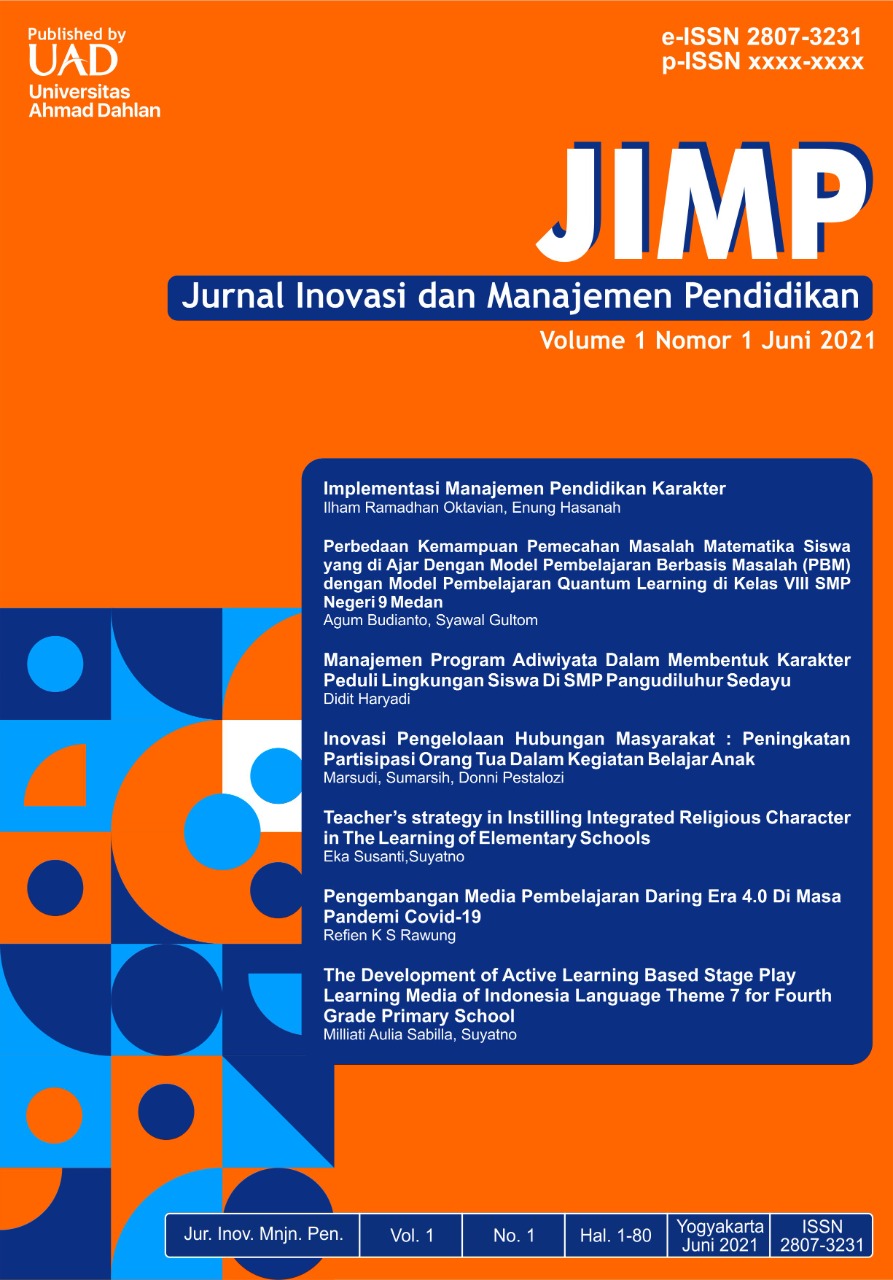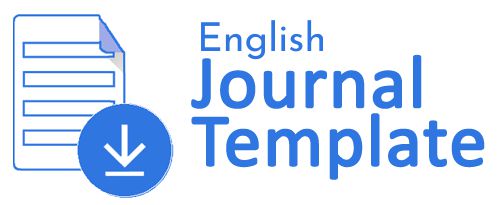Perbedaan Kemampuan Pemecahan Masalah Matematika Siswa Yang di Ajar dengan Model Pembelajaran Berbasis Masalah (PBM) dengan Model Pembelajaran Quantum Learning di Kelas VIII SMP Negeri 9 Medan
DOI:
https://doi.org/10.12928/jimp.v1i1.4172Keywords:
Problem Solving, Problem Based Learning Model, Quantum Learning ModelAbstract
Pemecahan masalah siswa khususnya di dalam pelajaran matematika masih di kategorikan rendah. Penelitian ini bertujuan untuk mengetahui perbedaan kemampuan pemecahan masalah matematika siswa yang diajar dengan model pembelajaran berbasis masalah dan model pembelajaran quantum learning pada materi kubus dan balok di kelas VIII SMP Negeri 9 Medan T.A 2018/2019. Jenis penelitian ini adalah quasi eksperimen. Sampel yang diambil adalah kelas VIII-1 sebagai kelas eksperimen A yaitu kelas yang di ajar dengan model pembelajaran berbasis masalah dan kelas VIII-5 sebagai kelas eksperimen B yaitu kelas yang diajar dengan model pembelajaran Quantum Learning. Sampel penelitian dilihat berdasarkan kesamaan kondisi awal berdasarkan nilai rapor siswa. Kemudian prosedur yang pertama adalah memberi tes kemampuan awal kepada kelas yang diteliti. Dari hasil tes awal yang diperoleh menunjukkan bahwa nilai rata-rata observasi siswa dalam materi kubus dan balok adalah sebesar 34,75. Setelah dilakukan posttest pada kedua kelas, dan diperoleh hasil berupa rata-rata nilai kelas eksperimen A sebesar 65,184 dan rata-rata nilai kelas eksperimen B sebesar 58,333. Artinya, kedua kelas sampel penelitian mengalami kondisi yang berbeda terhadap kemampuan pemecahan masalah matematika setelah mendapat perlakuan. Berdasarkan pengujian hipotesis dapat disimpulkan bahwa terdapat perbedaan kemampuan pemecahan masalah matematika siswa yang di ajar menggunakan Model Pembelajaran Berbasis Masalah (PBM) dengan Model Pembelajaran Quantum Learning pada materi Kubus Dan Balok di kelas VIII SMP Negeri 9 Medan T.A 2018/2019.References
Astriani, N., Surya, E., & Syahputra, E. (2017). The Effect Of Problem Based Learning To Students ’ Mathematical Problem Solving Ability. IJARIIE, 3(2), 3441–3446.
Carson, J. (2007). A Problem With Problem Solving : Teaching Thinking Without Teaching Knowledge. Jurnal Of The Mathematics Educator, 17(2), 7–14.
DePorter, B. (2010). Quantum Teaching; Mempraktekkan Quantum Teaching di Ruang-Ruang Kelas. Kaifa.
Deswita. (2014). Psikologi Perkembangan Peserta Didik. Remaja Rosdakarya.
Fathurrohman, M. (2015). Model-Model Pembelajaran Inovatif. Ar-Ruzz Media.
Hanifatul, R. (2015). Peran Quantum Learning Menurunkan Kecemasan Matematika Siswa. Jurnal Tamaddun Ummah, 01(1), 1–8.
Hmelo-silver, C. E., Duncan, R. G., & Chinn, C. A. (2007). Scaffolding and Achievement in Problem-Based and Inquiry Learning : A Response to Kirschner , Sweller , and Clark ( 2006 ). EDUCATIONAL PSYCHOLOGIST, 42(2), 99–107.
Masrurotullaily, Hobri, & Suharto. (2013). Analisis Kemampuan Pemecahan Masalah Matematika Keuangan Berdasarkan Model Polya Siswa Smk Negeri 6 Jember.Jurnal Kadikma, 4(2), 129–138.
Panjaitan, M., Rajagukguk, S. R., Matematika, P. P., Utara, S., & Learning, P. B. (2017). Menggunakan Model Pembelajaran Problem Based Learning. Jurnal Inspiratif, 3(2), 1–17.
Schommer-aikins, M., & Hutter, R. (2012). Beliefs , Mathematical Beliefs , and Academic Students. The Elementary School Journal, 105(3), 289–304.
Shoimin, A. (2014). 68 Model Pembelajaran Inovatif dalam Kurikulum 2013. Ar-Ruzz Media.
Sudjana. (2005). Metoda Statistika. Tarsito.
Trianto, A. (2010). Mendesain Model Pembelajaran Inovatif-Progresif. Prenadamedia Group.
Ulvah, S., Afriansyah, E. A., Studi, P., & Matematika, P. (2016). Kemampuan Pemecahan Masalah Matematis Siswa ditinjau melalui Model Pembelajaran SAVI dan Konvensional. Jurnal Riset Pendidikan, 2(2), 142–153.
Downloads
Published
How to Cite
Issue
Section
License
This article's copyright is transferred to Universitas Ahmad Dahlan (UAD) if and when the item is accepted for publication. The undersigned hereby transfers any rights in and to the paper including without limitation all copyrights to UAD. The undersigned hereby represents and warrants that the article is original and that he/she is the author of the paper, except for material identified as to its source, with permission notices from the copyright owners where required. The undersigned represents that he/she has the power and authority to make and execute this assignment.
We declare that:
This paper has not been published in the same form elsewhere.
It will not be submitted anywhere else for publication before acceptance/rejection by this Journal.
Copyright permission is obtained for materials published elsewhere and which require this permission for reproduction.
Furthermore, I/We hereby transfer the unlimited rights of publication of the above-mentioned paper in whole to UAD. The copyright transfer covers the exclusive right to reproduce and distribute the article, including reprints, translations, photographic reproductions, microform, electronic form (offline, online), or any other reproductions of similar nature.
The corresponding author signs for and accepts responsibility for releasing this material on behalf of any co-authors. This agreement is to be signed by at least one of the authors who have obtained the co-author(s) assent where applicable. After submission of this agreement signed by the corresponding author, changes of authorship or in the order of the authors listed will not be accepted.
Retained Rights/Terms and Conditions
Authors retain all proprietary rights in any process, procedure, or article of manufacture described in the Work.
Authors may reproduce or authorize others to reproduce the Work or derivative works for the author's personal use or company use, provided that the source and the UAD copyright notice are indicated, the copies are not used in any way that implies UAD endorsement of a product or service of any employer, and the documents themselves are not offered for sale.
Although authors are permitted to re-use all or portions of the Work in other works, this does not include granting third-party requests for reprinting, republishing, or different types of re-use.







